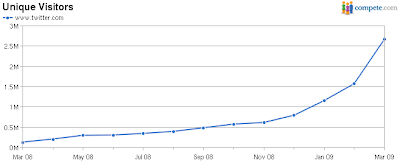
Twitter, the once esoteric microblogging utility has “crossed the chasm.” It is now popular, if not yet mainstream.
Consider:
In case you missed it, last Friday, 17 April 2009, was “Twitter Day” on Oprah. And Oprah has shown she can move markets, if not mountains. Not only is she on Twitter, but at least for Twitter Day was tweeting live on her show. Oprah herself has in a few days gone from a standing start to over 300 thousand followers. If you want the current stats on the followers, visit her Twitter page and see the block in the upper right corner.
Actor Ashton Kutcher became the first to amass a million followers on Twitter. This was not spontaneous. Rather it was the result of well orchestrated marketing campaign, including — you guessed it — Twitter.
Many radio and TV shows accept or even solicit listener input via Twitter, while businesses and organizations are actively playing with it.
During the presidential campaign of 2008, one Twitter account dominated all others. As you may have guessed this was Barack Obama’s. His campaign understood and applied social media better than any competing candidate. He currently has about 887 thousand followers.
In these depressed times, meteoric success like Twitters cheers me up – all the more so, because it was so improbable. Who’d a thunk it? Initially the experience of most Twitter users, and I include myself, was not love at first Tweet. Gradually, we found ways of making this lightweight utility pretty darn useful. Each of us did this in different ways with different constituencies.
All is, however, not well in the Twittersphere. It is very likely that increased traffic will strain Twitter’s servers. There will be more temporary interruptions in service just as we had come to depend on Twitter.
Among certain quarters, the objections are more profound and profoundly less rational. That is, by becoming popular, Twitter will loose the cachet it had by being esoteric, counterintuitive, or to many just plain weird. As in one of Yogi’s bon mot “it’s so crowded nobody goes there.”
- PR maven and Twitter user Steve Rubel posits the decline of Twitter because the geeks, who were its first patrons, will desert it for the next cool thing.
- Technology analyst Jeremiah Owyang, expects a backlash as Twitter approaches mainstream.
- While PC Magazine columnist Lance Ulanoff laments that “Oprah and Ashton will destroy Twitter.
I don’t think so. Email may be uncool, but it’s not going away anytime soon. Most of those who joined Twitter only because of Oprah may drop out, unless she starts Tweeting messages relevant to them. Those who find it useful will stay, no matter how they first got there.
